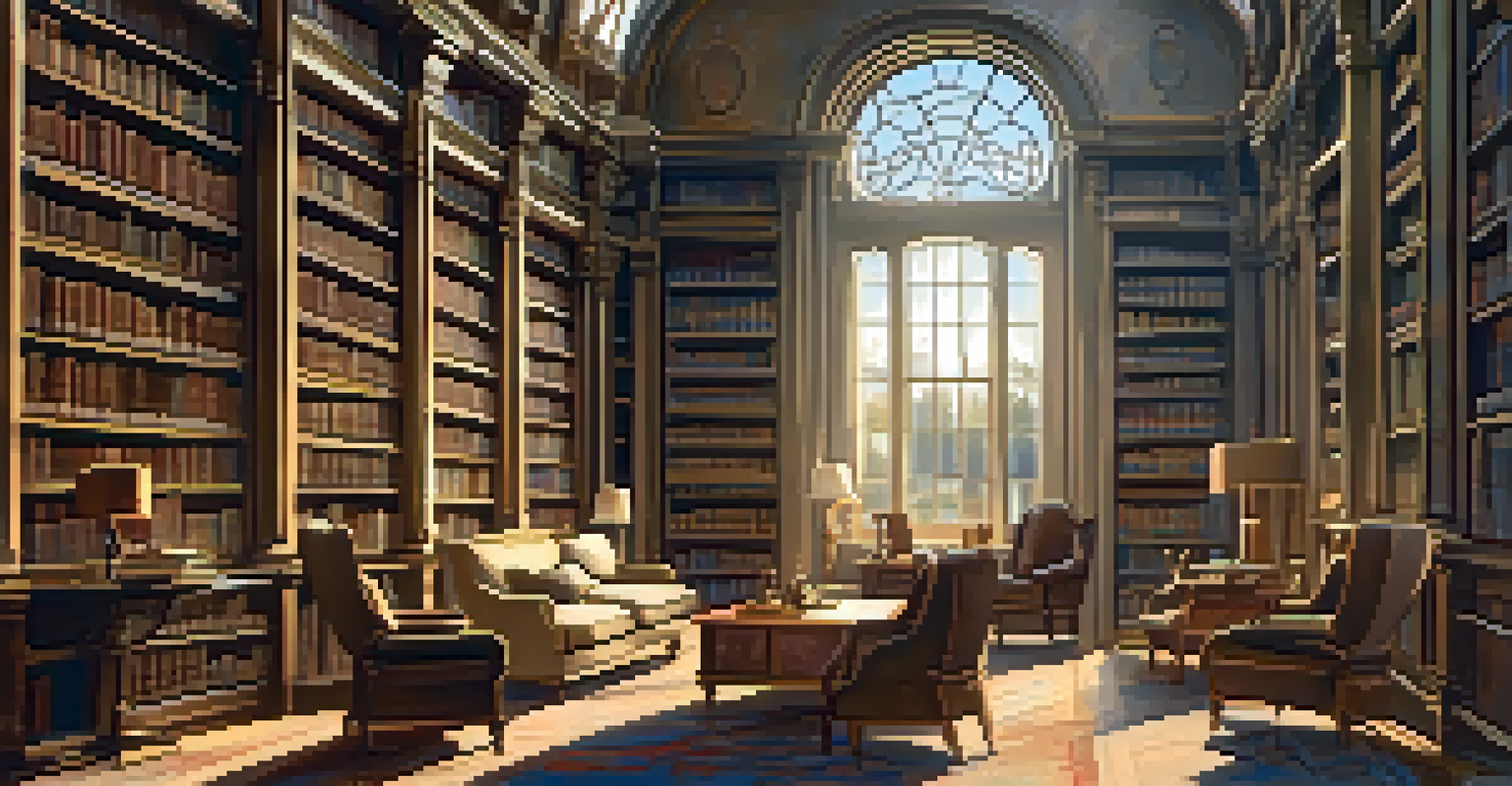Iconic Paintings That Shaped Political Narratives in History

Guernica: Picasso's Response to War and Suffering
Pablo Picasso's 'Guernica' is a haunting depiction of the horrors of war, specifically reflecting the devastation of the Spanish Civil War. Created in 1937, this monumental painting captures the anguish and chaos experienced by civilians caught in conflict. The stark black and white palette intensifies the emotional impact, making the viewer confront the brutality of violence.
Art is a lie that enables us to realize the truth.
By portraying suffering figures, such as the screaming mother and the fallen soldier, Picasso invites us to empathize with the victims of war. This artwork transcended its immediate context, becoming a powerful anti-war symbol that resonates even today. The painting's global recognition underscores how art can shape public consciousness and influence political discourse.
In essence, 'Guernica' serves as a reminder of the human cost of war, urging viewers to reflect on their own political realities. It highlights the artist's role in advocating for peace and justice, demonstrating how art can challenge oppressive narratives and inspire social change.
The Death of Sardanapalus: Delacroix and Revolution
Eugène Delacroix's 'The Death of Sardanapalus' is a vivid portrayal of chaos and rebellion, inspired by the fall of the Assyrian king. Created in 1827, this dramatic scene captures the moment of Sardanapalus' self-destruction amidst a backdrop of turmoil and defiance. The use of bold colors and dynamic brushstrokes conveys the intensity of the moment, drawing viewers into the chaos.

This painting is often interpreted as a metaphor for the political upheavals sweeping through France during Delacroix's time. The emotional fervor and sense of urgency reflect the artist's response to the revolutionary spirit of the 1830s. By depicting such a dramatic narrative, Delacroix highlights the interplay between art and politics, showcasing how artists can interpret and influence societal changes.
Art as a Reflection of War's Impact
Many artworks, like Picasso's 'Guernica' and Goya's 'The Third of May 1808', vividly depict the horrors of war, urging viewers to empathize with the suffering of victims.
Delacroix's work not only captures a historical moment but also serves as a commentary on the nature of power and the consequences of tyranny. It reminds us that art can provoke thought and inspire action, encouraging audiences to question authority and seek justice.
Liberty Leading the People: A Symbol of Freedom
Eugène Delacroix's 'Liberty Leading the People' is another iconic work that encapsulates the spirit of revolution. Painted in 1830, it celebrates the July Revolution in France, portraying Liberty as a powerful figure leading the charge for freedom. The allegorical representation of Liberty, holding the French flag, has become a universal symbol of the fight for democratic ideals.
The artist must be a philosopher; the philosopher, a work of art.
This painting not only reflects the political climate of its time but also inspires movements for liberty across the globe. The diverse group of revolutionaries depicted in the artwork embodies the collective struggle for justice, emphasizing the importance of unity in the face of oppression. Delacroix's masterful composition invites viewers to join in the fight for their rights.
Through 'Liberty Leading the People', Delacroix captures the essence of revolutionary fervor, showing how art can galvanize public sentiment. The painting continues to resonate with audiences, serving as a reminder of the ongoing quest for freedom and equality in various political contexts.
The Third of May 1808: Goya's Protest Against War
Francisco Goya's 'The Third of May 1808' is a striking depiction of the brutal reality of war, specifically the execution of Spanish rebels by French soldiers. Created in 1814, this artwork confronts viewers with the raw horror of violence, capturing the anguish and despair of a nation under siege. Goya's use of light and shadow emphasizes the stark contrast between the innocent victims and their ruthless oppressors.
The central figure, a man in white, symbolizes the spirit of resistance and defiance against tyranny. Goya's emotional portrayal serves as a powerful indictment of war, urging viewers to empathize with the suffering of those caught in its grasp. This piece reflects the artist's deep concern for humanity and his desire to provoke thought about the consequences of conflict.
Revolutionary Spirit in Art
Delacroix's paintings, such as 'Liberty Leading the People' and 'The Death of Sardanapalus', capture the essence of revolutionary fervor and the struggle for freedom.
By immortalizing this tragic event, Goya not only documents history but also creates a timeless plea for compassion and understanding. 'The Third of May 1808' is a reminder of the artist's role in shaping political narratives and influencing public opinion through the medium of art.
The School of Athens: Raphael's Vision of Knowledge
Raphael's 'The School of Athens' is a masterpiece that embodies the Renaissance ideals of knowledge and philosophy. Painted between 1509 and 1511, it showcases a gathering of great thinkers, including Plato and Aristotle, representing the synthesis of classical thought and modern inquiry. The architectural backdrop and intricate details invite viewers to immerse themselves in this intellectual celebration.
This painting reflects the political context of the Renaissance, emphasizing the importance of humanism and the resurgence of classical learning. By placing these philosophers in conversation, Raphael underscores the collaborative nature of knowledge and the value of discourse in shaping society. The artwork serves as a reminder of the power of education in informing political thought and governance.
Through 'The School of Athens', Raphael advocates for a society built on reason and understanding, illustrating how art can convey complex ideas about politics and philosophy. This masterpiece continues to inspire, encouraging us to seek wisdom and engage in meaningful dialogue.
American Progress: A Manifest Destiny Allegory
John Gast's 'American Progress' is an allegorical representation of Manifest Destiny, a 19th-century belief that the expansion of the United States was both justified and inevitable. Painted in 1872, the artwork depicts Columbia, a personification of America, leading civilization westward while pushing back Native Americans and wildlife. This imagery illustrates the complex and often controversial narrative of American expansion.
The painting reflects the political ideologies of its time, showcasing the belief in American superiority and the idea that progress was synonymous with expansion. Gast's portrayal of technological advancements, such as the telegraph and railroads, symbolizes the transformative impact of westward movement on American society. However, it also raises questions about the displacement and suffering of indigenous peoples.
Social Class and Identity in Art
Gainsborough's 'The Blue Boy' reflects the changing social dynamics of 18th-century England, illustrating the intersection of wealth, status, and identity.
Through 'American Progress', Gast captures the duality of progress—both as a force for innovation and as a catalyst for conflict. The artwork serves as a critical reminder of the narratives that shape national identity and the consequences of pursuing a singular vision of progress.
The Blue Boy: A Reflection of Social Class Dynamics
Thomas Gainsborough's 'The Blue Boy' is an exquisite portrait that offers insight into the social class dynamics of 18th-century England. Painted in the 1770s, this artwork features a young boy dressed in striking blue attire, symbolizing wealth and status. Gainsborough's masterful technique and attention to detail elevate the subject, inviting viewers to consider the intersection of art and social identity.
This painting reflects the evolving nature of class in Britain, as the rise of the middle class began to challenge the traditional aristocracy. The boy's confident pose and direct gaze suggest a sense of entitlement and ambition, embodying the aspirations of a changing society. Gainsborough's choice of color and composition emphasizes the importance of appearance and perception in social standing.

Through 'The Blue Boy', Gainsborough not only captures a moment in time but also comments on the societal shifts occurring during his lifetime. The artwork serves as a lens through which we can examine the complexities of class and identity, illustrating how art can reflect and influence political narratives.